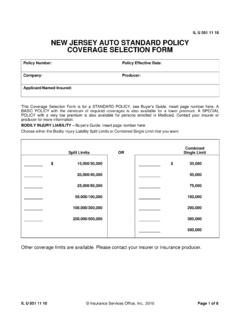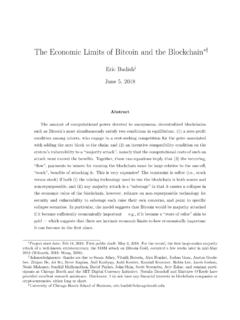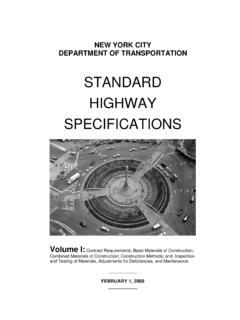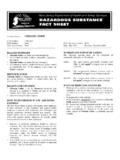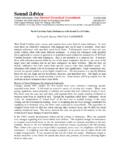Transcription of limiting oxygen concentration and flammability …
1 The limiting oxygen concentration and flammability limits of gases and gas mixtures Isaac A. Zlochower*,* Corresponding author. Tel.: 1 412 386 4960; fax: 1 412 386 6595. E-mail address: ( Zlochower). Gregory M. Green Pittsburgh Research Laboratory, National Institute for Occupational Safety and Health, Pittsburgh, PA 15236, USA abstract This paper presents data on the limiting (minimum) oxygen concentration (LOC), in the presence of added N2, of methane (CH4), propane (C3H8), ethylene (C2H4), carbon monoxide (CO), and hydrogen (H2), and some of their binary mixtures. It also addresses the issue of the flammable concentration (flammability) limits of these pure gases in air. The study is based on spark ignited explosions in large, spherical laboratory vessels (120-L and 20-L) using a 7% pressure-rise criterion for explosion propagation. The results of the study are compared with the older values which used long flammability tubes with a diameter 25 cm together with visual evidence of substantial upward propagation.
2 They are also compared to results reported recently using a 12-L spherical flask with a visual flame propagation criterion. Finally, they are compared to results reported in Europe using more modest flammability criteria and smaller chambers. The findings reported here show excellent agreement between the 120-L and 12-L results, good agreement with the 20-L results, and reasonable agreement with the earlier flammability tube values for the lower flammability limits . They disagree, however, with the more conservative European values. These results and those from the 12-L experiments also feature lower LOCs than are given by traditional flammability tubes. A model for the LOCs of such fuel mixtures based on the Le Chatelier mixture rule for lower flammable limits is seen to reasonably fit the observed results on binary mixtures and can accommodate more complex mixtures as well.
3 One such set of ternary mixtures containing CH4 and 1:1 CO:H2 is well fitted by the model. 1. Introduction Starting with basic definitions, the lower and upper flamma bility (or explosibility) limits (LFL and UFL, respectively) are the limiting fuel concentrations in air that can support flame propa gation and lead to an explosion. Fuel concentrations outside those limits are non-flammable. The progressive addition of an inert gas to a fuel air mixture causes the narrowing of the flammability range to the point where the two limits coincide. The limiting oxygen concentration (LOC) is the minimum O2 concentration in a mixture of fuel, air, and an inert gas that will propagate flame. In this paper, the inert gas will be nitrogen. In practice, the limits (LFL, UFL, and LOC) represent an average between the neighboring concentrations inside and outside the experimental flammability limits (ASTM International, 2008a, 2008b).
4 There is currently a significant difference of opinion between American and European based standard-setting organizations as to the prescribed test vessels and criteria for flammability and LOC determinations (ASTM International, 2008a, 2008b; British and European Standard, 2003, 2007). The traditional criterion used in the US, which was the basis of an extensive database of flamma bility limits , required that flame and explosion propagation be distinguished from ignition phenomena (Coward & Jones, 1952; Kuchta, 1985). In order to demonstrate unambiguous flame prop agation, standards required that flame be observed at some distance from the ignition source and to have traveled through a significant fraction of the enclosed volume. That requirement was relaxed in a more recent US standard that featured the use of a 5-L spherical glass flask, and mandated only that flame propagation be established by evidence of horizontal as well as vertical flame travel (ASTM International, 2008a).
5 Where ambiguity resulted, the stan dard called for using a larger (12-L) flask with a more extensive flame evolution a flame cone with an arc spanning at least 90 at the top of the flask, as measured from the point of ignition (ASH RAE, 2007; ASTM International, 2008a). The explosion overpressure in a closed system was, correspondingly, mandated to be 7%,1 , 1A 7% pressure increase represents a 1 psi increase starting at 1 bar ( psia) or 1 atm ( psia). a significant percentage of the initial value (ASTM International, 2008b). Although the exact flame travel distance or overpressure required for designation as a true flame propagation and explosion is somewhat subjective and apparatus-dependent, any attempt to minimize such requirements will lead to results that are subjective, apparatus-dependent, and overly conservative. Adding further to the problem, the flammability limits and LOCs when traditionally determined have no built-in safety factors.
6 In practice, therefore, such factors must be imposed. For example, NFPA 69 requires that the fuel concentration only reach 25% of the LFL value (or 60% of the LFL for gaseous systems with automated in-line sensors and controls) (NFPA 69, 2008). Imposing these factors has been the long-standing practice in the US (MSHA, 1996; NFPA 69, 2008). The current standard adopted by the European Union, based on the earlier German standard (DIN 51649, 1986), is a radical departure from the above considerations. In that standard (EN 1839T), a sepa ration of flame 10 cm above the s induction spark in an 8 x 30 cm cylinder defines a flammable mixture. The same is true if the flame extends to 24 cm without separation from the spark electrodes. The result is basically to substitute an ignitability criterion for flammability. For a closed spherical or cylindrical system with a minimum volume of 5-L and using such a centrally located induc tion spark, or fuse wire of 10 20 J nominal energy (EN 1839T), the corresponding criterion is a 5% pressure rise above that given by the source alone (British and European Standard, 2003).
7 Other European researchers go further and insist that any separation of flame from the ignition spark bespeaks a flammable mixture (meaning ignit able). The same applies to an overpressure that is just measurable (2%) (De Smedt et al., 1999). The LFLs and LOCs resulting from such minimal flame propagation criteria are, understandably, lower than those resulting from the traditional ones since they have a built-in safety factor. Despite these concerns the primary purpose of this article is not to critique the European methodology, but to alert the readers to the current existence of incompatible flammability data bases; the US database (Coward & Jones, 1952; Kuchta, 1985; NFPA, 2008; Zabetakis, 1965) and the European one (CHEMSAFE, 2007). More refined techniques often lead to the revision of earlier data and to progress in the field of study. Revisions based on new arbitrary criteria, however, tend to produce confusion.
8 Moreover, the incom patible databases may lead to the misapplication of traditional safety factors to the already conservative European data. This caution has already been issued by Britton (2002) and is echoed in this paper. 2. Experimental The flammability data reported here were obtained in the spherical 120-L and 20-L chambers used in earlier studies (Cash dollar, Zlochower, Green, Thomas, & Hertzberg, 2000). The internal diameter of the 120-L chamber is 60 cm and its pressure rating is 69 bar. Instrumentation includes a sensitive strain-gauge pressure transducer to measure the partial pressures as the gases are added and mixed, and a higher capacity strain-gauge pressure transducer to monitor the explosion pressure. The strain-gauges have a response time of 1 ms. The pressure transducers were mounted on the top and bottom flanges of the chamber. A fine wire thermo couple near the top of the chamber was used to record the steady-state temperature after the addition of each gaseous component.
9 There were also ports with ball valves for connection to a vacuum pump and vent. An internal non-sparking fan at the bottom of the vessel was used to mix the gases. The gases were added via a manifold and controlled via manual switches in an isolated control room where the additions, pressure monitoring, mixing and spark ignition initiation, and PC recording were conducted. The spark ignition system consisted of 3-mm diameter metal rod electrodes with a durable plastic spacer for rigidity. The pointed spark electrodes terminated below the center of the sphere and were bent to face each other with a gap of 6 mm. The electrical energy so delivered came from a 1300 mF capacitor charged to 300 V which was then discharged through a transformer to generate a strong spark. This spark was powered by a stored energy on the capacitor of 58 J based on the equation: stored energy 1/2CE2, where C is the capacitance and E is the voltage.
10 The actual electrical energy in the spark gap was considerably less, however, because of the low efficiency of the transformer circuit (Hertzberg, Conti, & Cashdollar, 1985). The calibrations of the pressure transducers were checked daily using the internal shunt calibration resistors provided by the manufacturer. Samples of the gas mixtures could be collected in evacuated test tubes through a sampling needle on the side of the chamber. These samples were then analyzed by gas chromatography (GC). During the initial evaluation of the mixing efficiency in the 120-L chamber, samples of H2 air mixtures were collected after the gases had been added to the chamber and after 2 and 5 min of mixing by the fan. There was essentially no difference in the measured concentrations of H2 for the gas mixtures over this time period, showing that there was good mixing of the gases even before the fan was turned on.










